The Samsung Galaxy Note7 (S820) Review
by Joshua Ho on August 16, 2016 9:00 AM ESTBattery Life
Obviously, battery life is one of the most important aspects of any smartphone, tablet, or other mobile device shipping today. The main point of interest for a lot of people seems to be battery life as even though we’re approaching what might be considered a full day of use a lot of people seem to need quite a bit more as battery life demands can vary dramatically from day to day. If you sit in an office for much of your day with the phone next to a charger then battery life demands are going to be relatively light but if you have to deal with a 12 hour flight with a 2 hour wait for a transfer before another 4 hour flight then you’re probably going to find that most devices are not going to have the ability to get you through a full “day” if your day of use involves 9 hours of usage between movies, games, web browsing, and other data synchronization tasks. This is obviously an extreme case but if you’ve ever done a trans-pacific flight this isn’t that far-fetched if you can’t fall asleep for at least 10 hours of the ~16 hour flight.
In order to try and test this properly then we turn to our 2016 suite of benchmarks which allow for proper characterization of battery life in fairly realistic workloads. In order to make for useful relative comparisons we disable all background tasks and set the display for all devices to 200 nits on a blank white screen for all tests. In the case of the Galaxy Note7 due to its similarity to the Galaxy S7 edge we’ve elected to run a compressed version of our suite although if time permits we’ll be adding additional results and commentary.
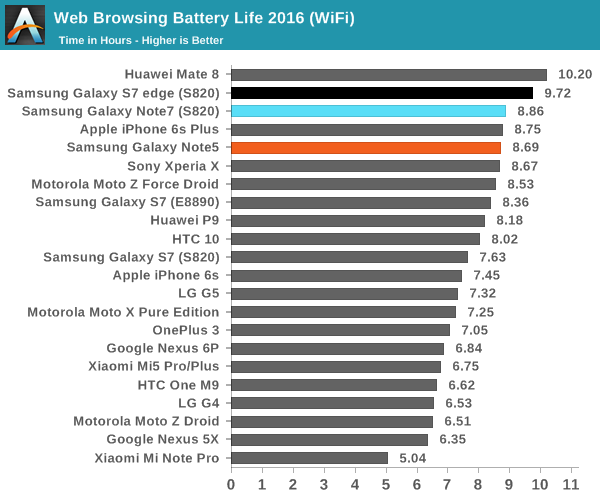
With that said we can start with the WiFi test which shows about an 8% drop for the Note7 relative to the Galaxy S7 edge. This might be surprising to some but given that the display area of the Note7 is 7% larger and the battery is about 3% smaller it’s not all that surprising as I wouldn’t be surprised if literally everything but display has identical power consumption on the Galaxy Note7.
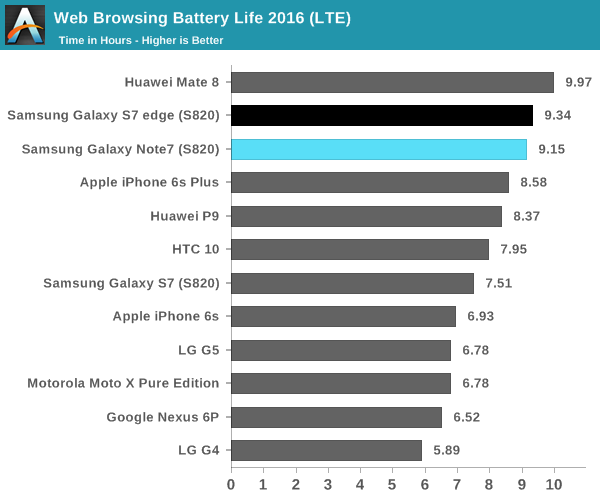
While the WiFi test result is pretty much in line with expectation the LTE test result is visibly different and somewhat surprising to see. It’s tempting to explain the relative difference change away as a function of Verizon and T-Mobile LTE differences but reception was fairly comparable across both test units and both were tested on LTE. Given that the Note7 has 4x4 MIMO for cellular connectivity I suspect that there are some RF front-end changes that distinguish the Note7 from the S7 edge but the RF front-end is only visible to the modem rather than the overall system so unless the modem itself can be accessed I suspect the most viable method of figuring out the changes here will be a device teardown which isn’t in the scope of this review.
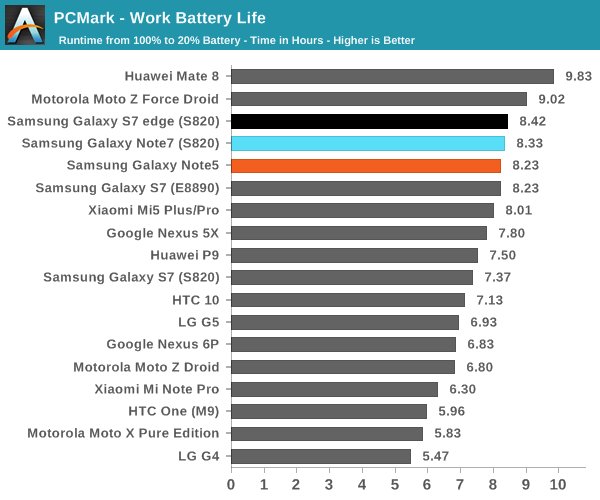
The next point of interest is going to be PCMark which shows how close the Galaxy S7 edge and Note7 are in WiFi and CPU bound tasks as they last basically an identical amount of time and have fairly comparable performance if you get both on the same version of software. Due to time constraints I would refer back to the Galaxy S7 Part 2 Review if you are interested in seeing what heavy workload battery life is like, but overall the Galaxy Note7 keeps fairly good battery life even if it isn't as great as the Galaxy S7 edge.
Charge Time
Of course, while battery life is critical we need to also talk about the other side of the equation which is how quickly it can charge. After all, if you’re stuck in an airport waiting for your connection and burn off most of your battery in the process, it’s going to be fairly painful conserving battery until you get to your destination because your phone can’t charge quickly enough to compensate for additional usage. In order to test something like this, we rely on measurements from the wall and waiting until the power draw from the wall reaches a specified level that indicates full charge has been reached. In the case of the Galaxy Note7, the charger uses QC 2.0 or Samsung’s adaptive fast charge technology depending upon the AC adapter you’re using, and internally the battery charger IC is a TI BQ25898S which contains a buck converter that can take a 9V or 12V input and step it down to the appropriate voltage for the battery with supports for current up to four amps at roughly 90% efficiency.
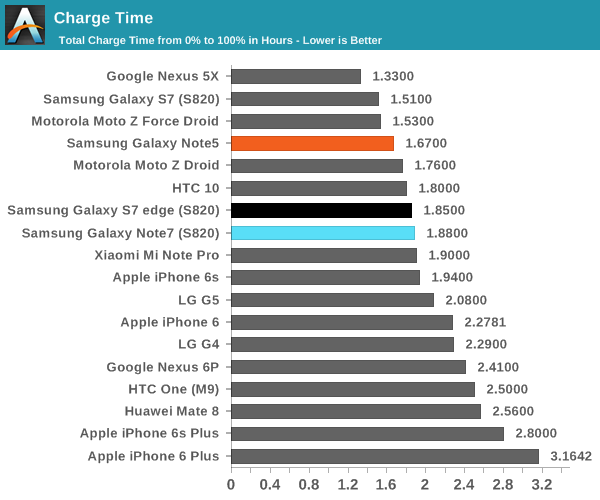
Looking at the overall charge time the Galaxy Note7 performs respectably as it reaches full charge in under two hours and takes basically as much time as the Galaxy S7 edge, which is probably not a surprise given their similar battery capacities. For the most part I think we’ve hit an upper bound here as far as charge time goes. The real challenge now is to focus on reducing the heat output and impact to battery longevity that these fast charging solutions have similar to OnePlus’ Dash Charge and Qnovo’s Adaptive Charging technologies.


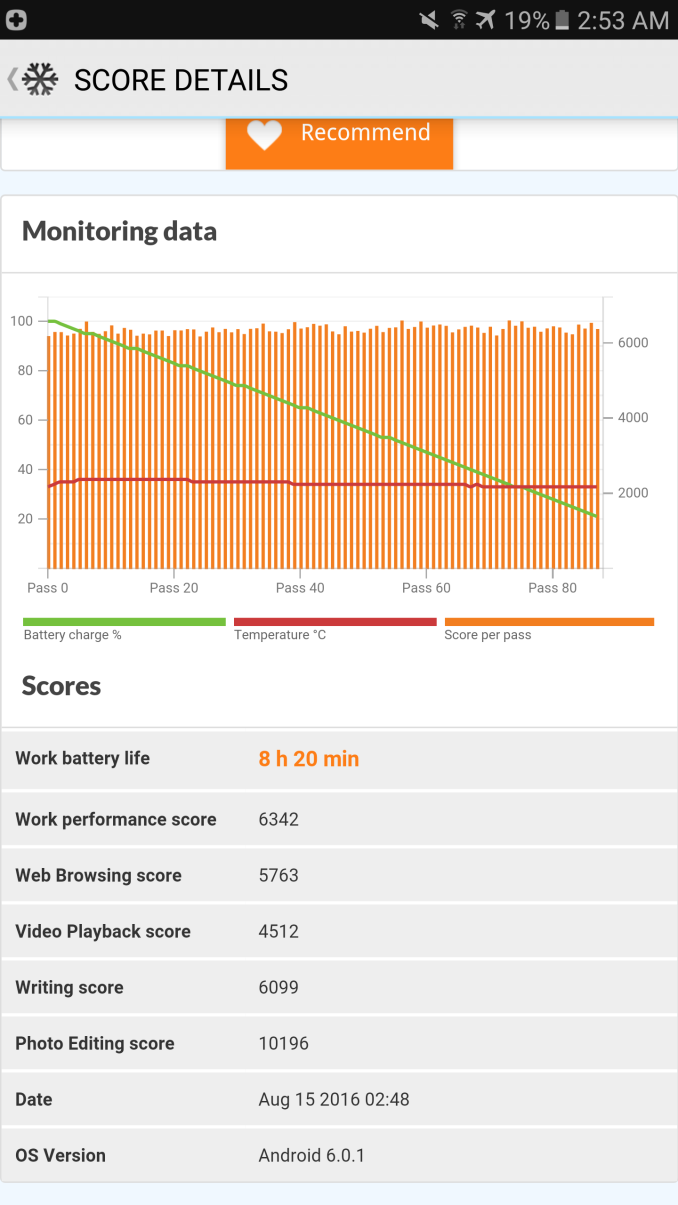
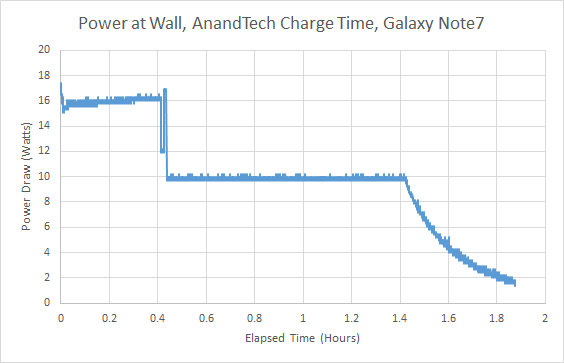








202 Comments
View All Comments
HideOut - Tuesday, August 16, 2016 - link
"You also get an extra 32 GB of storage which does justify the extra 100 USD that bumps the Note7 up to 850 USD."You must work for apple if you somehow think that 32Gb of on board storage is worth $100. FFS its about 1/5 that to buy in any other format.
bJammin - Tuesday, August 16, 2016 - link
Sorry for a nitpick, but this isn't the first phone with an iris scanner, though probably the first with wide availability. Fujitsu's is only available in Japan right now, but I have one as my company phone. The phone and scanner are actually pretty slick too despite being based on older tech, though Fujitsu's interface is pretty awful.http://www.gsmarena.com/fujitsus_latest_phone_is_w...
Vagabondjonez - Tuesday, August 16, 2016 - link
Still no htc 10 review or a Twitter response....Lau_Tech - Tuesday, August 16, 2016 - link
Well done on the improvements in timeliness and tone, Josh. I certainly agree with other reader opinions that the S-Pen deserved a full page of its own, given that it continues to be a distinguishing factor from all other phones. I understand that it may feel unnecessary if its the same as last years models, but it is still worth a re-look and run through. After all, Samsung's screens have not changed much either, and you still ran them through a gamut of tests.I must say that your continued placement of Samsung's AMOLED's as being "one of the best" or equal to Iphones to be have long since been untenable. Samsung's AMOLED beats or equals the Iphones in every one of your metrics. Colour-shifting remains the sole issue, but is not on its own sufficient to deny Samsung's phones the title of "best display, period".
Lau_Tech - Tuesday, August 16, 2016 - link
I should also point out that your (justified) decision to be nit-picky about design must be applied fairly to your upcoming iphone 7 review as well.If you intend to highlight design issues that do not affect the user experience (as has been done in this review), I would expect that you find fault with the Iphone 7s IF the Iphone 7s maintain the unwieldy bezel sizes of the 6 plus, and the added inconvenience of the USB-only audio jack. These should count as negatives against the Iphone 7s.
Your criteria for commenting on design must be seen as fair.
JoshHo - Wednesday, August 17, 2016 - link
If there's a real demand for this sort of ID analysis I'll keep going with it.To outline some of my personal thoughts for design:
1. I don't see a ton of value to extremely thin bezels. Excessive bezel like the M8/M9 is one thing but the 6s Plus had no issues with ergonomics in use. I view phablets as phones that need two hands to be used but still fit in one pocket so I don't pay that much attention to bezel unless it's really egregious like the M8/M9.
2. The S-Pen would have received further analysis but battery life testing alone took up a full 3 days. It's been made clear to me that timeliness is critical so I would rather cut out discussion on things that are fairly well understood and revisit it in future short-form than cut out data that answers essential questions.
3. To me AMOLED's color shifting issues are fairly significant and power efficiency in high APL scenarios is still lagging slightly behind LCD. If power efficiency rises above LCD then I would say shipping LCD would automatically count as a negative against an OEM, but until that comes to pass I think it's important to weigh these things on a case by case basis.
4. If the iPhone 7 loses the 3.5mm jack it would require close examination and weighing of the advantages and disadvantages. I would trend towards likely being a bad idea but we'll have to see how it plays out. There are a lot of ways this could be executed and some are good but others are awful.
Lau_Tech - Wednesday, August 17, 2016 - link
Thanks for the detailed reply Josh, I appreciate the time taken.Im definitely with you with regards to points 2 and 4. I think with regards to points 1 and 3 we will have to agree to disagree.
I look forward to the HTC 10 review, of which I am already an owner. I'm sure you'll be able to point out interesting things about this device (some nuggets already present in this review)
jlabelle2 - Friday, August 19, 2016 - link
I am also quite shocked about the change on editorial note (because it seems really to be that) since Anand departure. Even with Anand working for Apple, reviews were still much more factual.I have an iPhone 6S but honestly, there is not denying that the S7 Edge and Note 7 are just a marvel of design.
Also, saying that bezels do not matter is NOT a matter of opinion. We are speaking of phablet here and the very reason why not everyone have 6" phones is the size of those phones. So when the Note 7 include a 5,7" screen in a form factor which is 5mm shorter and 4mm narrower than a 5,5" iPhone 6+, this is huge achievement and has a significant competitive advantage compare to the iPhone or other bulkier large phone.
At last, how can anyone still defend LCD against Samsung OLED screen implementation? The argument that there would be color shifting when looking the phone from the side (which obviously no one is doing) shows the extent of bad faith.
Again, as an iPhone (and Windows phone user), and having no Android, I am puzzled by such review and what kind of goal is tried to be achieved...
NitT - Tuesday, August 16, 2016 - link
I feel like I am a minority here as I am OK with Touchwiz. I do not feel any lagging. On the other hand, when I use other Android phones such as HTC or Vivo, I feel that I miss so many settings. My latest HTC phone was HTC M7/M8. It is quite sad as I could not find newer HTC flagship models in my country.WoodyPWX - Wednesday, August 17, 2016 - link
Finally someone who isn't afraid to say something bad about Note 7. Every other reviews are practically without any real criticism. Thanks for a honest review!